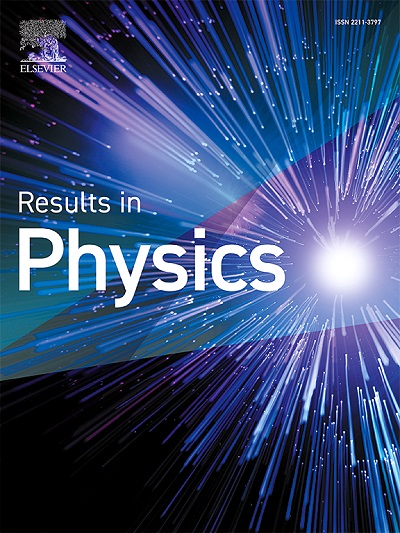Efficient detection of specific volatile organic compounds using functionalized titanium carbide (Ti3C2Tx) MXenes
IF 4.6
2区 物理与天体物理
Q2 MATERIALS SCIENCE, MULTIDISCIPLINARY
引用次数: 0
Abstract
Early diagnosis of cancer is crucially important for prescribing a therapy plan to possibly save human lives. Towards this end, one amongst the pathologies is to consider the efficient detection of volatile organic compounds (VOCs) related, for instance, to the pancreatic cancer existing in exhaled breath, bile, or urine of patients. The scope of the present investigation is to search for suitable materials used for detecting the specific VOCs with high sensitivity and selectivity. The density functional theory (DFT) is employed to study the adsorption of three representative pancreatic cancer biomarkers; namely, (i) 2-pentanone (2p-none), (ii) 4-ethyl-1–2-dimethylbenzene (4E1-2DMB), and (iii) N-nonanal (N-nonal) on the pristine titanium carbides MXenes (Ti3C2Tx, Tx = O, S, F) as well as doped with selected transition metals “TMs” (e.g., Co, Cu, Fe, Ni). At the level of pristine MXenes, a clear selective adsorption towards the three VOCs is obtained as compared to the interfering air molecules (N2, O2, CO2, H2O) with suitable adsorption energies ranging from −0.60 eV to −1.10 eV. Furthermore, the strongest adsorption of VOCs is always found to correspond to Ti3C2O2 MXenes. Four different scenarios of TM-doping were considered and among which two cases are found to be effective to enhance the adsorptions of VOCs with effects on Fermi states. These latter two cases correspond to TM-doping O site and TM ad-atom. Adsorptions of VOCs on Cu-doped MXenes is found to have mimic effect on Fermi states and thus Cu should be excluded from the candidature. We concluded that TM-doping Ti3C2O2 MXenes (with TM = Co, Fe, Ni) should be a good candidate material for fabrication of platform of disposable biosensor with high selectivity towards the detection of pancreatic cancer biomarkers.

功能化碳化钛(Ti3C2Tx) MXenes高效检测特定挥发性有机化合物
癌症的早期诊断对于制定可能挽救生命的治疗方案至关重要。为此,病理学之一是考虑对挥发性有机化合物(VOCs)的有效检测,例如,与患者呼出的气、胆汁或尿液中存在的胰腺癌有关。本研究的范围是寻找合适的材料用于检测特定的挥发性有机化合物,具有高灵敏度和选择性。采用密度泛函理论(DFT)研究了三种具有代表性的胰腺癌生物标志物的吸附;即(i) 2-戊酮(2p-none), (ii) 4-乙基-1 -2 -二甲苯(4E1-2DMB)和(iii) n -壬醛(n - nononal)在原始碳化钛MXenes (Ti3C2Tx, Tx = O, S, F)上,并掺杂了选定的过渡金属“TMs”(如Co, Cu, Fe, Ni)。与干扰空气分子(N2, O2, CO2, H2O)相比,在原始MXenes水平上,对3种VOCs具有明显的选择性吸附,适宜的吸附能范围为- 0.60 eV至- 1.10 eV。此外,对VOCs的吸附最强的总是Ti3C2O2 MXenes。考虑了四种不同的tm掺杂情况,发现其中两种情况可以有效地增强VOCs的吸附,并影响费米态。后两种情况对应于TM掺杂O位和TM ad-原子。发现VOCs在Cu掺杂MXenes上的吸附对费米态具有模拟效应,因此应将Cu排除在候选物之外。我们认为TM掺杂Ti3C2O2 MXenes (TM = Co, Fe, Ni)是一种用于制造高选择性胰腺癌生物标志物检测的一次性生物传感器平台的良好候选材料。
本文章由计算机程序翻译,如有差异,请以英文原文为准。
求助全文
约1分钟内获得全文
求助全文
来源期刊

Results in Physics
MATERIALS SCIENCE, MULTIDISCIPLINARYPHYSIC-PHYSICS, MULTIDISCIPLINARY
CiteScore
8.70
自引率
9.40%
发文量
754
审稿时长
50 days
期刊介绍:
Results in Physics is an open access journal offering authors the opportunity to publish in all fundamental and interdisciplinary areas of physics, materials science, and applied physics. Papers of a theoretical, computational, and experimental nature are all welcome. Results in Physics accepts papers that are scientifically sound, technically correct and provide valuable new knowledge to the physics community. Topics such as three-dimensional flow and magnetohydrodynamics are not within the scope of Results in Physics.
Results in Physics welcomes three types of papers:
1. Full research papers
2. Microarticles: very short papers, no longer than two pages. They may consist of a single, but well-described piece of information, such as:
- Data and/or a plot plus a description
- Description of a new method or instrumentation
- Negative results
- Concept or design study
3. Letters to the Editor: Letters discussing a recent article published in Results in Physics are welcome. These are objective, constructive, or educational critiques of papers published in Results in Physics. Accepted letters will be sent to the author of the original paper for a response. Each letter and response is published together. Letters should be received within 8 weeks of the article''s publication. They should not exceed 750 words of text and 10 references.
 求助内容:
求助内容: 应助结果提醒方式:
应助结果提醒方式:


